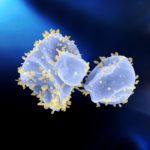Link to Pubmed [PMID] – 27137505
J. Bacteriol. 2016 Jul;198(14):1952-64
The temperate haloarchaeal virus SNJ1 displays lytic and lysogenic life cycles. During the lysogenic cycle, the virus resides in its host, Natrinema sp. strain J7-1, in the form of an extrachromosomal circular plasmid, pHH205. In this study, a 3.9-kb region containing seven predicted genes organized in two operons was identified as the minimal replicon of SNJ1. Only RepA, encoded by open reading frame 11-12 (ORF11-12), was found to be essential for replication, and its expression increased during the lytic cycle. Sequence analysis suggested that RepA is a distant homolog of HUH endonucleases, a superfamily that includes rolling-circle replication initiation proteins from various viruses and plasmids. In addition to RepA, two genetic elements located within both termini of the 3.9-kb replicon were also required for SNJ1 replication. SNJ1 genome and SNJ1 replicon-based shuttle vectors were present at 1 to 3 copies per chromosome. However, the deletion of ORF4 significantly increased the SNJ1 copy number, suggesting that the product of ORF4 is a negative regulator of SNJ1 abundance. Shuttle vectors based on the SNJ1 replicon were constructed and validated for stable expression of heterologous proteins, both in J7 derivatives and in Natrinema pallidum JCM 8980(T), suggesting their broad applicability as genetic tools for Natrinema species.
IMPORTANCE: Archaeal viruses exhibit striking morphological diversity and unique gene content. In this study, the minimal replicon of the temperate haloarchaeal virus SNJ1 was identified. A number of ORFs and genetic elements controlling virus genome replication, maintenance, and copy number were characterized. In addition, based on the replicon, a novel expression shuttle vector has been constructed and validated for protein expression and purification in Natrinema sp. CJ7 and Natrinema pallidum JCM 8980(T) This study not only provided mechanistic and functional insights into SNJ1 replication but also led to the development of useful genetic tools to investigate SNJ1 and other viruses infecting Natrinema species as well as their hosts.


